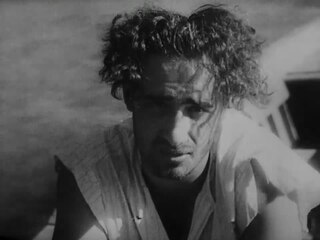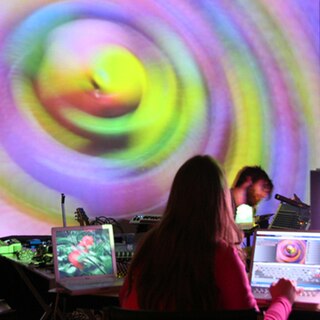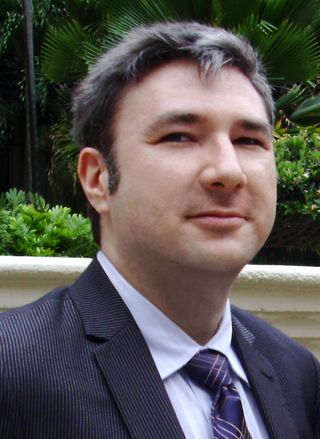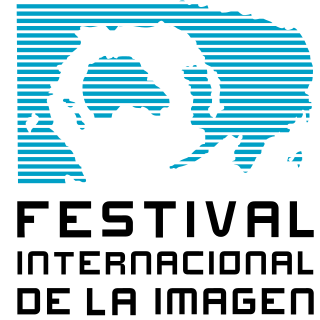
Digital art refers to any artistic work or practice that uses digital technology as part of the creative or presentation process. It can also refer to computational art that uses and engages with digital media.

The demoscene is an international computer art subculture focused on producing demos: self-contained, sometimes extremely small, computer programs that produce audiovisual presentations. The purpose of a demo is to show off programming, visual art, and musical skills. Demos and other demoscene productions are shared at festivals known as demoparties, voted on by those who attend and released online.

Pixel art is a form of digital art drawn with graphical software where images are built using pixels as the only building block. It is widely associated with the low-resolution graphics from 8-bit and 16-bit era computers, arcade machines and video game consoles, in addition to other limited systems such as LED displays and graphing calculators, which have a limited number of pixels and colors available. The art form is still employed to this day by pixel artists and game studios, even though the technological limitations have since been surpassed.

Experimental film or avant-garde cinema is a mode of filmmaking that rigorously re-evaluates cinematic conventions and explores non-narrative forms or alternatives to traditional narratives or methods of working. Many experimental films, particularly early ones, relate to arts in other disciplines: painting, dance, literature and poetry, or arise from research and development of new technical resources.

Yellow Submarine is a 1968 animated jukebox musical fantasy surrealist adventure comedy film inspired by the music of the Beatles, directed by animation producer George Dunning, and produced by United Artists and King Features Syndicate. Initial press reports stated that the Beatles themselves would provide their own character voices. However, apart from composing and performing the songs, the real Beatles' only participation was in the closing scene of the film; the voices of their animated counterparts were provided by voice actors.
Patti Schmidt is a Canadian radio personality, curator, creative producer, musician and DJ from Montreal, Quebec. She is best known for her tenure as host and executive producer of CBC Radio 2's long-running alternative music program Brave New Waves from 1995 to 2007.

VJing is a broad designation for realtime visual performance. Characteristics of VJing are the creation or manipulation of imagery in realtime through technological mediation and for an audience, in synchronization to music. VJing often takes place at events such as concerts, nightclubs, music festivals and sometimes in combination with other performative arts. This results in a live multimedia performance that can include music, actors and dancers. The term VJing became popular in its association with MTV's Video Jockey but its origins date back to the New York club scene of the 1970s. In both situations VJing is the manipulation or selection of visuals, the same way DJing is a selection and manipulation of audio.

Michael Betancourt is a critical theorist, film theorist, art & film historian, and animator. His principal published works focus on the critique of digital capitalism, motion graphics, visual music, new media art, theory, and formalist study of motion pictures.

Computer graphics deals with by generating images and art with the aid of computers. Today, computer graphics is a core technology in digital photography, film, video games, digital art, cell phone and computer displays, and many specialized applications. A great deal of specialized hardware and software has been developed, with the displays of most devices being driven by computer graphics hardware. It is a vast and recently developed area of computer science. The phrase was coined in 1960 by computer graphics researchers Verne Hudson and William Fetter of Boeing. It is often abbreviated as CG, or typically in the context of film as computer generated imagery (CGI). The non-artistic aspects of computer graphics are the subject of computer science research.
Nathan Jurevicius is a Canadian/Australian illustrator, director, toy designer, author, and fine artist whose diverse range of work has appeared in numerous publications, advertising campaigns, festivals, and galleries around the world.

The International Image Festival is a space for meeting and discussion on topics related to visual design, electronic art, digital audiovisual creation, digital sound, and electro-acoustic, and in general, new relationships between art, design, and science and technology. Proposing an open forum for discussion in areas of digital creation, integrating art, science and technology through different activities and projects, such as: art and science conferences, seminars and workshops, calls for national and international events including new music concerts, analysis sessions, exhibitions, publications and webcast initiatives.

Tom Sito is an American animator, animation historian and teacher. He is currently a Professor at USC's School of Cinematic Arts in the Animation Division. In 1998, Sito was included by Animation Magazine in their list of the One Hundred Most Important People in Animation.
The history of computer animation began as early as the 1940s and 1950s, when people began to experiment with computer graphics – most notably by John Whitney. It was only by the early 1960s when digital computers had become widely established, that new avenues for innovative computer graphics blossomed. Initially, uses were mainly for scientific, engineering and other research purposes, but artistic experimentation began to make its appearance by the mid-1960s – most notably by Dr. Thomas Calvert. By the mid-1970s, many such efforts were beginning to enter into public media. Much computer graphics at this time involved 2-D imagery, though increasingly as computer power improved, efforts to achieve 3-D realism became the emphasis. By the late 1980s, photo-realistic 3-D was beginning to appear in film movies, and by mid-1990s had developed to the point where 3-D animation could be used for entire feature film production.

Glitch art is an art movement centering around the practice of using digital or analog errors, more so glitches, for aesthetic purposes by either corrupting digital data or physically manipulating electronic devices. It has been also regarded as an increasing trend in new media art, with it retroactively being described as developing over the course of the 20th century onward.
Joel Trussell is a director, executive producer and artist based in Los Angeles, California. He most recently was an executive producer for the adult, animated, dark comedy Captain Fall for Netflix Animation. Before that he was an executive producer at Disney Television Animation for the Disney XD show Pickle and Peanut which he helped develop alongside the creator Noah Z. Jones.
"My Fare Lady" is the fourteenth episode of the twenty-sixth season of the American animated television series The Simpsons, and the 566th overall episode of the series. The episode was directed by Mike Frank Polcino and written by Marc Wilmore. It originally aired on the Fox network in the United States on February 15, 2015. It is the first episode where Bart has no dialogue even though he appears. He did not appear at all in the earlier episode "Four Great Women and a Manicure".
Nqobizitha "Enqore" Mlilo is a Zimbabwean video director, animator, new media artist and educator from Bulawayo, based in Harare. He released Zimbabwe's first fully animated music video in 2002 at the age of 18 for artist/presenter, Babongile, while still based in his home town, Bulawayo.
Takeshi Murata is an American contemporary artist who creates digital media artworks using video and computer animation techniques. In 2007 he had a solo exhibition, Black Box: Takeshi Murata, at the Hirshhorn Museum and Sculpture Garden in Washington, D.C. His 2006 work "Pink Dot" is in the Hirshhorn's permanent collection, and his 2005 work "Monster Movie" is in the permanent collection of the Smithsonian American Art Museum. His 2013 short film "OM Rider" was selected to screen as an animated short film at the 2015 Sundance Film Festival.

Mari Kim (Korean: 마리킴) is a South Korean contemporary artist from Seoul, South Korea. She is known for the big-eyed, cartoon-like female characters in her pop art paintings, called "eyedolls". Her work was popularly recognized after her 2011 collaboration with the K-pop girl group 2NE1, directing the animated music video for their single "Hate You". The single topped charts and the music video, with eyedoll action heroines portraying each of the four members, received over twenty million YouTube views.

Paperbark is an Australian point-and-click exploration video game by Paper House, released June 2018.











